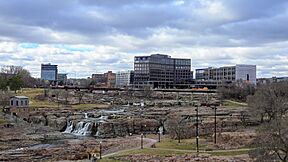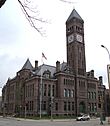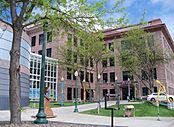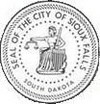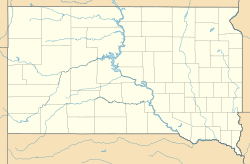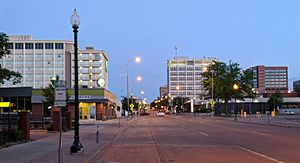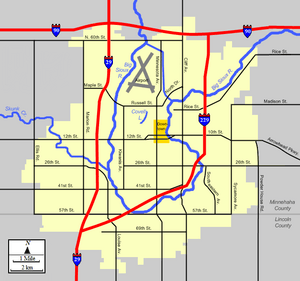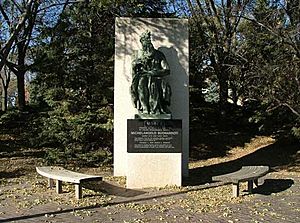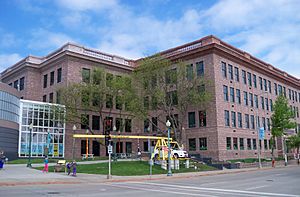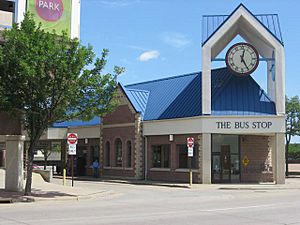Sioux Falls, South Dakota facts for kids
Quick facts for kids
Sioux Falls, South Dakota
|
|||||
|---|---|---|---|---|---|
|
Sioux Falls skyline as seen from Falls Park
Old Minnehaha County Courthouse
Denny Sanford Premier Center
|
|||||
|
|||||
| Nickname(s):
Best Little City in America, Queen City of the West, The Heart of America
|
|||||
| Country | United States | ||||
| State | South Dakota | ||||
| Counties | Minnehaha | ||||
| Founded | 1856 | ||||
| Incorporated | February 4, 1879 | ||||
| Named for | The waterfall of the Big Sioux River | ||||
| Area | |||||
| • City | 81.19 sq mi (210.27 km2) | ||||
| • Land | 80.64 sq mi (208.87 km2) | ||||
| • Water | 0.54 sq mi (1.40 km2) | ||||
| Elevation | 1,463 ft (446 m) | ||||
| Population
(2020)
|
|||||
| • City | 192,517 | ||||
| • Estimate
(2023)
|
206,410 | ||||
| • Rank | US: 121st SD: 1st |
||||
| • Density | 2,387.25/sq mi (921.72/km2) | ||||
| • Urban | 194,283 (US: 197th) | ||||
| • Urban density | 2,861.3/sq mi (1,104.8/km2) | ||||
| • Metro | 289,592 (US: 171st) | ||||
| • Metro density | 112.5/sq mi (43.42/km2) | ||||
| Demonym(s) | Siouxlander (unofficial) | ||||
| Time zone | UTC–6 (Central (CST)) | ||||
| • Summer (DST) | UTC–5 (CDT) | ||||
| ZIP codes |
Zip codes
|
||||
| Area code(s) | 605 | ||||
| Sales tax | 6.2% | ||||
| GNIS feature ID | 1267566 | ||||
Sioux Falls (pronounced soo-_-fawlz) is the largest city in South Dakota. It is the 118th most populated city in the whole United States. Sioux Falls is the main city in Minnehaha County. Part of it also reaches into Lincoln County.
In 2020, about 192,517 people lived here. By early 2024, the city estimated its population grew to over 213,000. More than 30% of South Dakota's people live in the Sioux Falls area. The city started in 1856 along the Big Sioux River. It is located where Interstate 29 and Interstate 90 meet.
Contents
History of Sioux Falls, South Dakota
The story of Sioux Falls is all about the beautiful waterfalls on the Big Sioux River. These falls were formed about 14,000 years ago during the last ice age. Many Native American groups lived here before Europeans arrived. These included the Ho-Chunk, Lakota, and Cheyenne people. They built farming villages and burial mounds near the river. Today, many Native Americans still live in Sioux Falls.
Early European Exploration and Settlement
French explorers visited the area in the early 1700s. The first American of European descent to visit was Philander Prescott in 1832. In 1856, two groups, the Dakota Land Company and the Western Town Company, decided to claim the land. They thought the waterfalls would be a great spot for a town. They built a small fort called "Fort Sod" to protect themselves. Seventeen men spent the first winter in Sioux Falls.
Challenges and Growth of the City
In 1862, during the Dakota War of 1862, the town was emptied. Two settlers were killed, and everyone moved to Yankton. The empty town was then robbed and burned.
In 1865, a military base called Fort Dakota was set up. Slowly, people started to return. By 1873, the population grew to 593. The village of Sioux Falls became a city in 1883.
The arrival of railroads in the 1880s caused a huge boom. The population jumped from 2,164 in 1880 to 10,167 by 1890. But a grasshopper problem and a national economic downturn slowed growth in the 1890s.
Things got better with the opening of the John Morrell meat packing plant in 1909. An airbase and military training school opened in 1942. The interstate highways were finished in the early 1960s. These things helped the city grow. In 1955, Sioux Falls joined with the nearby city of South Sioux Falls.
Modern Growth and Economy
In 1981, Citibank moved its main credit card center to Sioux Falls. This happened because South Dakota changed its banking laws. Many people believe this move helped the city's population and job growth. Sioux Falls changed from a city based on industry to one focused on healthcare, finance, and shopping.
Sioux Falls has grown very fast since the late 1970s. The population went from 81,182 in 1980 to 192,517 in 2020.
2019 Tornadoes in Sioux Falls
On September 10, 2019, three strong tornadoes hit the south side of Sioux Falls. They damaged at least 37 buildings. One tornado hit the Avera Heart Hospital, causing roof and window damage. Seven people were hurt, including one man who broke his skull. Another tornado hit a busy shopping area near the Empire Mall. The total damage was over $5 million.
Geography of Sioux Falls
Sioux Falls is located in eastern South Dakota. It is about 15 miles west of the Minnesota border. The city covers about 73.47 square miles. Most of this area is land, with a small amount of water.
Sioux Falls Metropolitan Area
The Sioux Falls Metropolitan Area includes four counties in South Dakota. These are Lincoln, McCook, Minnehaha, and Turner counties. In 2017, about 259,094 people lived in this area. Lincoln County is one of the fastest-growing counties in the United States.
Parks and Recreation in Sioux Falls
Sioux Falls has over 70 parks and green spaces. One famous park is Falls Park, which is built around the city's waterfalls. Other popular parks include Terrace Park, McKennan Park, and Sherman Park.
The city has a paved 19-mile path for biking, jogging, and walking. This path follows the Big Sioux River and forms a loop around the city. The city has been improving parts of the bike trails downtown. These improvements include wider paths, new lighting, and a new pedestrian bridge.
Great Bear Recreation Park offers skiing, snowboarding, and tubing in the winter. The South Dakota Department of Game, Fish, and Parks has an outdoor campus at Sertoma Park. It offers activities like stargazing and snowshoeing.
Climate in Sioux Falls
Sioux Falls has a climate with hot, humid summers and cold, dry winters. The average temperature in January is about 17.9°F. In July, it's about 74.4°F. The city gets about 45.3 inches of snow each year. Most rain falls in the warmer months. This often leads to thunderstorms in the summer. Temperatures can range from a very cold -42°F to a very hot 110°F.
Population and People of Sioux Falls
| Historical population | |||
|---|---|---|---|
| Census | Pop. | %± | |
| 1880 | 2,164 | — | |
| 1890 | 10,177 | 370.3% | |
| 1900 | 10,266 | 0.9% | |
| 1910 | 14,094 | 37.3% | |
| 1920 | 25,202 | 78.8% | |
| 1930 | 33,362 | 32.4% | |
| 1940 | 40,832 | 22.4% | |
| 1950 | 52,969 | 29.7% | |
| 1960 | 65,466 | 23.6% | |
| 1970 | 72,488 | 10.7% | |
| 1980 | 81,182 | 12.0% | |
| 1990 | 100,814 | 24.2% | |
| 2000 | 123,975 | 23.0% | |
| 2010 | 153,888 | 24.1% | |
| 2020 | 192,517 | 25.1% | |
| 2023 (est.) | 206,410 | 34.1% | |
| U.S. Decennial Census 2020 Census |
|||
Sioux Falls has grown a lot over the years. In 2020, there were 192,517 people living in the city. The city has many different groups of people. In 2020, about 77.62% of the population was White. About 6.27% were Black or African American. Native Americans made up about 2.46% of the population. Asian people were about 2.74%. People of Hispanic or Latino background made up about 6.37% of the population.
The average age in Sioux Falls in 2010 was 33.6 years. About 24.6% of residents were under 18. Many immigrants, especially from Scandinavia, Germany, and the British Isles, settled in South Dakota in the 1800s.
Religions in Sioux Falls
Many people in Sioux Falls are Lutheran. The Catholic faith is the second largest group. The Evangelical Lutheran Church in America has 20 churches in the city. The Lutheran Church–Missouri Synod has eight churches. The Wisconsin Evangelical Lutheran Synod has two churches.
The Roman Catholic Diocese of Sioux Falls built St. Joseph Cathedral, which was finished in 1919. Sioux Falls is also home to the Episcopal Diocese of South Dakota.
The Church of Jesus Christ of Latter-day Saints has three groups meeting in one building. There is a small Hindu community that uses the Hindu Temple of Siouxland nearby. The Chabad Jewish Center serves the Jewish population in South Dakota. There are also three Islamic centers in the city.
Economy of Sioux Falls
Sioux Falls has a strong economy. Many financial companies are located here because South Dakota does not have a state corporate income tax. Large employers include Wells Fargo and Citigroup.
The manufacturing and food processing industry is also important. The Smithfield Foods/John Morrell meatpacking plant is one of the city's biggest employers.
Top Employers in Sioux Falls
Here are some of the largest employers in Sioux Falls:
| # | Employer | Industry | # of Employees |
|---|---|---|---|
| 1 | Sanford Health | Health Care | 11,010 |
| 2 | Avera Health | Health Care | 7,888 |
| 3 | Sioux Falls School District | Education | 3,688 |
| 4 | Smithfield Foods (John Morrell) | Meat Processing | 3,400 |
| 5 | Hy-Vee | Retail Grocery | 2,806 |
| 6 | Wells Fargo | Financial | 2,035 |
| 7 | Walmart/Sam's Club | Retail | 1,547 |
| 8 | City of Sioux Falls | Government | 1,477 |
| 9 | Citigroup | Financial | 1,400 |
| 10 | Department of Veterans Affairs Medical & Regional Office | Medical | 1,214 |
Arts and Culture in Sioux Falls
Fun Events in Sioux Falls
Downtown Sioux Falls hosts a SculptureWalk every summer. "First Fridays" are held on the first Friday of each summer month. The Downtown Riverfest brings live music, art, and kids' activities.
The Festival of Bands is a competition for over 40 marching bands. The Sioux Empire Spectacular is a Drum Corps competition. Party in the Park is an outdoor music event at Terrace Park. The Sioux Empire Fair is a regional fair at the W. H. Lyon Fairgrounds. The Sioux Falls JazzFest is held at Yankton Trail Park each year.
SiouxperCon is a yearly fan convention. It celebrates comic books, sci-fi, fantasy, anime, board games, and video games.
Art and Creativity in Sioux Falls
Sioux Falls has become a hub for arts and culture. The Sioux Empire Arts Council supports the arts scene. They give out Mayor's Awards each year for excellence in different art forms. The Sioux Falls SculptureWalk displays over 55 sculptures, including a copy of Michelangelo's David.
The Washington High School building was renovated into the Washington Pavilion. It now has performing arts, visual arts, and a science center. The Northern Plains Indian Art Market (NPIAM) showcases art from Native American artists. A permanent collection of this art is at the Washington Pavilion.
Poetry and literary events have also grown in popularity. The Sioux Falls Jazz and Blues Festival is a free, three-day outdoor music event. It features two stages and happens every July.
Other art spots include Ipso Gallery, the Orpheum Theater, and the Sioux Falls State Theater. Levitt at the Falls hosts free concerts in an outdoor amphitheater. The Washington Pavilion is home to the South Dakota Symphony Orchestra.
Famous Landmarks in Sioux Falls
The Washington Pavilion is a major landmark. It has the Kirby Science Discovery Center and two performing arts centers. These centers host Broadway shows and operas. The Visual Arts Center inside the Pavilion has six galleries with changing exhibits, all free to visit. The Wells Fargo Cinedome is a large dome theater that shows films and planetarium shows.
The Great Plains Zoo & Delbridge Museum has animal exhibits. The taxidermy animals from the Delbridge Museum were removed in 2023.
The USS South Dakota Battleship Memorial honors the World War II battleship USS South Dakota. It is located on State Highway 42.
A copy of Michelangelo's David statue is at Fawick Park.
The 114th Fighter Wing is at Joe Foss Field. It houses F-16C/D fighter jets.
Sports in Sioux Falls
Sioux Falls has several sports teams and venues.
| Club | League | Venue | Established | Championships |
|---|---|---|---|---|
| Sioux Falls Canaries | AAIPB, Baseball | Sioux Falls Stadium | 1993 | 1 |
| Sioux Falls Stampede | USHL, Ice hockey | Denny Sanford Premier Center | 1999 | 3 |
| Sioux Falls Storm | IFL, Indoor football | Denny Sanford Premier Center | 2000 | 11 |
| Sioux Falls Skyforce | NBA G League, Basketball | Sanford Pentagon | 1989 | 3 |
| Sioux Falls Thunder FC | NPSL, Soccer | McEneaney Field | 2017 | 0 |
| Sioux Falls City FC | WPSL, Soccer | University of Sioux Falls | 2022 | 0 |
The Sioux Falls Canaries baseball team was once called the Sioux Falls Fighting Pheasants. Famous baseball player Patrick Mahomes Sr. pitched for the Canaries in 2007 and 2008.
Sporting Event Venues
Sioux Falls has several large sports venues. These include Sioux Falls Stadium for baseball and the indoor Sioux Falls Arena. The Sanford Pentagon and Denny Sanford Premier Center are also indoor venues.
The Denny Sanford Premier Center opened in 2014. It hosts the Summit League's men's and women's basketball tournaments. It also hosted the 2016 Division I Women's Basketball Tournament Regional.
Education in Sioux Falls
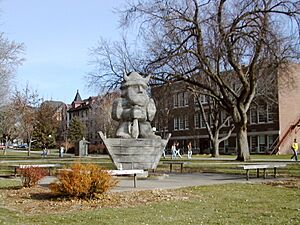
Colleges and Universities
Sioux Falls is home to several colleges and universities:
- Augustana University
- University of Sioux Falls
- Sioux Falls Seminary
- Southeast Technical College
- National American University
- South Dakota School for the Deaf
- University of South Dakota's Sanford School of Medicine (Sioux Falls campus)
- Stewart School
- South Dakota Public Universities and Research Center
Public Schools in Sioux Falls
The Sioux Falls School District serves over 23,000 students. It covers most of Sioux Falls and some nearby areas. There are 25 elementary schools, seven middle schools, and six high schools. The high schools include:
- Axtell Park Building
- Career and Technical Education Academy
- Lincoln High School
- Roosevelt High School
- Jefferson High School
- Washington High School
Other school districts also cover parts of Sioux Falls. These include Tea Area, Brandon Valley, Tri-Valley, and Lennox School Districts.
Private Schools in Sioux Falls
Bishop O'Gorman Catholic Schools is a system of Catholic schools. It includes six elementary schools, one junior high, and one high school. About 2,800 students attend these schools.
The Lutheran Church-Missouri Synod runs two schools in Sioux Falls. These are Sioux Falls Lutheran School and the Lutheran High School of Sioux Falls. The Wisconsin Evangelical Lutheran Synod also has two schools: Bethel Lutheran and Good Shepherd Lutheran.
Other private schools include Sioux Falls Christian Schools, Christian Center, The Baan Dek Montessori, Cornerstone School, and Open Arms Christian Child Development Center.
Getting Around Sioux Falls
Roads and Highways
Most people in Sioux Falls use cars to get around. Interstate 90 runs east to west across the north side of the city. Interstate 29 goes north and south through the western part of the city. Interstate 229 forms a loop around Sioux Falls.
The city is building a new highway called South Dakota Highway 100. This highway will go around the southern and eastern edges of the city.
Public Transportation
Sioux Area Metro is the local public bus system. It has 16 bus lines that run Monday through Saturday. They recently added a new bus transfer station. Sioux Area Metro also offers a special service called SAM On Demand. This service helps people who cannot use regular bus routes.
Jefferson Lines offers long-distance bus routes from the Sioux Falls Bus Station. You can travel to cities like Minneapolis and Kansas City.
Air Travel
Many airlines offer flights from Sioux Falls Regional Airport.
Rail Service
The BNSF Railway provides freight train service. However, Amtrak passenger trains do not stop in South Dakota.
Famous People from Sioux Falls
- James Abourezk, first Arab-American U.S. senator
- Erika M. Anderson, musician
- Jacob M. Appel, author
- Shayna Baszler, professional wrestler
- George Botsford, composer
- Chris Browne, cartoonist
- Dallas Clark, professional football player
- Devin Clark, UFC fighter
- Donn Clendenon, MLB first baseman
- Dusty Coleman, MLB infielder
- Brian Cummings, voice actor
- Chris Darrow, musician
- Karl Dean, former mayor of Nashville
- Nick Dinsmore, WWE Superstar
- Wallace Dow, architect
- Walker Duehr, professional ice hockey player
- Oscar Randolph Fladmark, World War II pilot
- James D. Ford, former Chaplain of the U.S. House
- Terry Forster, MLB pitcher
- Joe Foss, World War II pilot and former governor
- Michael E. Fossum, astronaut
- Neil Graff, NFL quarterback
- Mary Hart, TV personality
- Allison Hedge Coke, writer
- Stephanie Herseth Sandlin, U.S. representative
- January Jones, actress
- Herbert Krause, author
- David Lillehaug, Minnesota Supreme Court justice
- Mike Martz, former NFL coach
- Gail Matthius, actress
- Milton J. Nieuwsma, author
- Pat O'Brien, TV personality
- David Soul, actor
- John Thune, South Dakota senator
- Shane Van Boening, professional pool player
- Jerry verDorn, actor
Sister Cities of Sioux Falls
Sioux Falls has special connections with two other cities around the world:
 Newry, Mourne and Down District Council, Northern Ireland, United Kingdom
Newry, Mourne and Down District Council, Northern Ireland, United Kingdom Potsdam, Germany
Potsdam, Germany
See also
 In Spanish: Sioux Falls para niños
In Spanish: Sioux Falls para niños


